The signage category in the personalization industry is a labyrinth of possibility. From elaborate digital displays and directional cues and banners to window and vehicle graphics, effective signage is a meaningful way to enhance brand awareness, drive foot traffic, provide instruction, and communicate promotions.
By Stefanie Galeano-Zalutko
(Originally printed in the July/August 2025 issue of Insights.)

“The [increased] accessibility of sign-making materials and equipment allows small shops to grow their customer bases in ways that weren’t possible just five years ago,” says Jackie Faeth, marketing coordinator at TRG (The Rowmark Group).
Sumita Patel, co-owner of Home Bound Custom Decor in Alpharetta, Georgia, is a prime example of a small business thriving in a nearly $30 billion global market ripe with opportunity. She and her husband added signage to their company in 2024. Since then, they’ve seen a 15% increase in business.
Business signage and wedding festivities specifically are sweet spots for the personalization shop. From utilitarian wayfinding and QR codes to custom table numbers, seating charts, and bar menus, Patel says there are plenty of possibilities to craft memorable signage.
“As business owners, we often come across products that we believe would do well but ultimately make the decision to diversify based on a product falling within a certain range of profit margin,” Patel says.
Doing so ensures the cost of doing business is always covered and the product is a lucrative item for the shop to sell. Patel says this rule of thumb applies to the product selection at large, including signage, and is a successful barometer.
Over the years, taking calculated risks and creating variation in a sea of sameness has elevated their brand. Today, Patel is a “mentor of fellow makers” and encourages entrepreneurs to stay abreast of leading market trends, forge exclusive partnerships, invest in proper equipment, and find unique ways to make a mark in a competitive space.
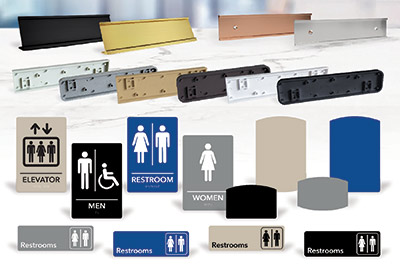
Image courtesy of Contact USA
Practical Possibilities
The need for signage is visible on nearly every neighborhood corner—from commercial and government contracts to fleet services, health care systems, and educational institutions. Schools and universities, in particular, proudly display full-color signage throughout their campuses, covering walls, benches, banners, and even digital displays.
While academic and athletic clubs may be challenging relationships to kick-start, they pay dividends in the long haul.
“Remember, you don’t always need to be the mouthpiece for your business. Rely on your network within [in order] to help build bridges in the community,” says Kerrie Mallory-Thompson, marketing specialist at MUTOH America, a manufacturer of wide-format printers, cutters, inks, and accessories. “Someone on your team has kids enrolled in school or playing sports. Someone on your team likely knows a [parent] on the PTA. Get in the right way—lean on your team to network on behalf of the business.”
Construction is another segment on the rise post pandemic, fueling significant growth in both internal and external signage.
“Return-to-office mandates are driving some of the signage growth, as companies begin to undertake refreshing work environments that were delayed in recent years,” Faeth says, stressing public and private buildings alike require identification and wayfinding signage.
Compliance with sign regulations is a challenge turned opportunity for businesses. As a best practice, Faeth recommends working alongside local building inspectors to ensure signage plans meet local regulations and codes.
Doing so is yet another critical touchpoint, an olive branch establishing rapport and positioning the business for long-term success.
“There is a ton of growth in construction [and adjacent segments],” Patel says, noting signage shops have the advantage of building those relationships at the ground level. “As they grow, you’re going to be first in line and growing right alongside them.”
Similarly, the hospitality industry is booming with opportunity, including parking lot, front desk, hallway, and special-event and pool-area signage, to name a few. Patel recalls a large local hotel brand requesting emergency-exit signage in 300-plus rooms.
While the signage was not trendy or flashy, the volume order was profitable and could be replicated and expedited easily at various locations, a win for both the signage shop and hotel management.
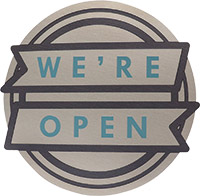
Image courtesy Rowmark
Practical possibilities in signage also include Wi-Fi plaques, room numbers, and laser-engraved light-switch plates. Unfortunately, partnering with business or property managers and landlords on such projects is often a missed opportunity, Patel says.
“Something so simple can be a bulk order throughout multiple buildings,” she explains, encouraging shop personnel to pursue local trade partnerships with more vigor.
Patel also stresses the importance of evaluating traditional offerings and considering how to reinvent or further maximize their use. While yard signs for lawn-care, real estate, and roofing companies are personally branded materials, Patel says there are plenty of opportunities to craft and sell well-designed stock options too. From graduations to weddings and baby showers, a solid but standard design and pleasing color palette serves as a versatile offering, especially as it relates to general wayfinding.
Yard signs of all kinds “can be used anywhere there is dirt,” Patel reminds.
Market Trends
There continues to be a shift toward environmentally friendly selections and manufacturing practices, in signage and beyond. Eco-solvent materials, for example, offer a more durable, more sustainable, and safer alternative than traditional solvent-based products.
Such options have evolved tremendously in quality and cost effectiveness in recent years. Renowned for their scratch and fade resistance, eco-solvent materials can withstand various weather conditions. As such, they are a reliable choice for outdoor applications like banners and vehicle wraps.
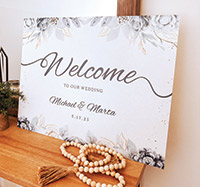
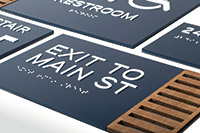
Images courtesy Home Bound Custom Decor
Plus, since eco-solvent materials rely on biodegradable solvents and materials that minimize harmful emissions like volatile organic compounds, they are less toxic compared to traditional solvent-based materials.
“Even substrates for sublimation are expanding, making it a viable technology for offering signs,” Faeth says, noting advancements across the board are expanding opportunities for local shops to be more competitive when bidding for small to midsize signage jobs.
When it comes to interior signage, she notices a renewed interest in engravable and UV-printable flat plastics, which supports a trend in cheaper, easier-to-use UV-LED printers, as well as smaller-format laser engravers.
“Two-ply engravable materials like those from Rowmark and Innovative Plastics Inc. are the most common options for interior and small-format exterior signage. They’re easy to personalize with a laser or rotary engraver and come in a variety of color combinations,” Faeth says. “In addition, both manufacturers offer materials that can be UV-LED printed, making them a great option for sign shops that use multiple forms of technology.”
For many, UV printing is changing the game—minimizing previous limitations, expanding possibilities, and improving profitability. As quality improves and costs come down, the equipment is becoming more accessible. While there’s still a learning curve, Faeth says today’s systems are easier to operate and require less maintenance than earlier models.
“In addition, there are more options available for UV-LED printers, with large, well-known printer manufacturers such as Epson offering models with smaller footprints that are ideal for shops of all sizes,” she says.
The UV-printing landscape certainly is more “dialed in,” says Mallory-Thompson.
“UV technology has quadrupled in the past 10 years,” she says, emphasizing that the switch from halogen to LED lights allows a project to cure instantly. “Now, you can produce a sign in two to three minutes, instead of two to three hours.”
Mallory-Thompson says eco-solvent and full-wrap materials are increasingly popular in the segment, easily applied before and peeled off after an event.
Faeth says wireless technology is another area of notable progress, evolving leaps and bounds during the past five years, thus making digital signage easier to use and more accessible—particularly for interior applications.
“Digital display boards for hospitality, dining, and health care are much more commonplace today,” she says.
Stocked Up
For some, the entire signs business model revolves around stock signage. Contact USA in Elk Grove Village, Illinois, for example, is an industry leader in Americans with Disabilities Act (ADA) signage, among other tried-and-true company products.
A significant portion of interior signage must meet ADA standards in public spaces, including restrooms, stairways, and exits. ADA signage, including braille text, raised characters, and specific font sizes, is in high demand. The specialized product is an attractive offering for signage shops but, over the years, was often imported from overseas.
“We worked to change that,” says Craig Petersen, president of Contact USA. Two years ago, Petersen and his team saw a niche in the market and built molds that enable them to create one-piece signs with the braille molded into the plastic. “There simply can’t be a more durable product with low production costs than one that uses plastic injection.”
Today, Contact USA’s ADA stock signage is available in four colors and manufactured at the company’s Chicago facility. In addition, the company is exploring in-mold labeling (IML) to create wood-grain and marble effects, appealing alternatives to traditional black-and-white options that have dominated the market for 30 years.
“I like to do things the competitor can’t or won’t do,” Petersen says, referring to his variety of SKUs and the steps involved in the plastic-injection process.
Currently, the team at Contact USA is testing plastic blends to create attractive alternatives without the use of polycarbonate film.
“This will add another dimension without the cost of IML,” Petersen says, emphasizing company personnel are constantly seeking better ways to freshen up product selections.
Faeth agrees ADA compliance presents business-building opportunities for traditional signage, awards, and personalization shops. Materials such as Rowmark ADA-compliant sheet plastic offer a wide range of colors that meet contrast guidelines for ADA signs and fit with various decor or design aesthetics, she says.
And, when paired with products such as Accent Raster braille beads, pens, and rotary-engraver attachments, customers have access to everything needed to produce attractive, fully compliant signage, Faeth adds.
Looking ahead, the future is bright in ADA signage. Research shows ADA trending in eco-friendly materials and manufacturing methods; interactive, touch screen, and digital signage; voice-controlled and audio-infused signage; as well as Made in the USA options.
“I have long said that stock signs help sell custom signs,” Petersen says.
For example, a stock ADA-compliant sign may cost a few dollars in ink and materials but retail for $20 or more. A customer requests a small change and suddenly the stock-turned-custom sign is selling for three to four times the original price.
Similarly, a client is pleased with a restroom-signage purchase then decides to follow up and inquire about additional stock or custom signage throughout the business.
In both instances, stock signage naturally evolves into high-dollar custom signage opportunities. However, since most sign makers heavily focus on customization due to high margins, they often overlook stock signage as a valuable stepping stone or linkable sale in business.
“It gets lost in the shuffle and is a big missed opportunity,” Petersen says.
However, in recent years, more personalization shops are starting to see the opportunity and are rounding out their product selections with stock signage, effectively entering new markets, broadening their customer bases, and increasing profitability.
Equipment
Ideally, shop owners reach a point where investing in advanced equipment makes strategic sense to fully tap into signage’s potential. From laser and rotary engravers to small-format UV-LED and sublimation printers, each machine creates distinct business-building opportunities.
Industry professionals encourage business owners to start small: Assess both budding and mature macro and niche markets, research complementary equipment options, diversify accordingly, and differentiate in the details.
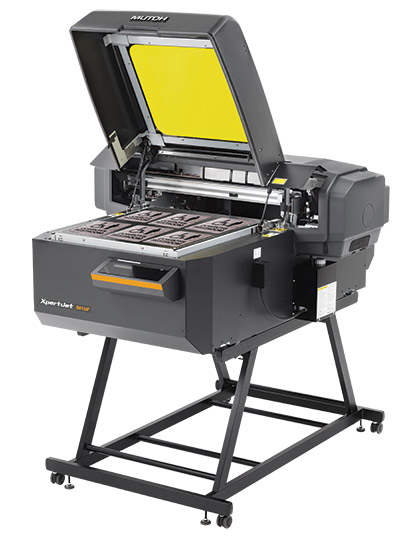
Image courtesy MUTOH
“Adding just one personalization method could open many doors,” Faeth says.
Patel stresses the importance of exploring all options before procuring equipment.
“These aren’t light purchases. Take your time to find a good fit—the right fit,” she says. “Analyze if that equipment can not only accomplish what you need today, but also scale your business and sustain growth tomorrow.”
For Mallory-Thompson, quality is paramount. While many manufacturers source key materials or specific parts from overseas, she warns shop owners to be cautious of suppliers who piecemeal all components to create a single finished product.
“You get what you pay for,” Mallory-Thompson says. “Invest once, and invest well. Otherwise, you’re wasting your money off the bat.”
Faeth also encourages businesses to fast-track their market knowledge and subsequent business opportunities by taking advantage of free and low-cost resources.
“APA member forums are a great place to ask questions, and suppliers like Rowmark have a lot of free downloads for customers making signage, particularly centered around creating ADA-compliant signage,” she says.
Looking Ahead
As technology improves and materials become more accessible, the signage segment continues to evolve—and it’s paying off for shops that are ready to invest. From small-format UV-LED printers and tabletop lasers to eco-friendly substrates and ADA-compliant options, suppliers are offering more tools than ever for retailers to enter or expand in the signage space.
These advancements support a wide range of common signage needs—from room numbers and nameplates to wayfinding signs and branded plaques—allowing shops to diversify while delivering custom products.
“Technological advancements combined with greater accessibility is bringing more people into the fold,” Patel says. “The entire maker community is getting better year after year. With more [entrepreneurs] investing in their dreams, the industry at large is poised to grow.”
Stefanie Galeano-Zalutko leads Zalutko Business Services, Inc., a
marketing agency based in central Florida. She can be reached at
szalutko@zalutkobusiness.com.
